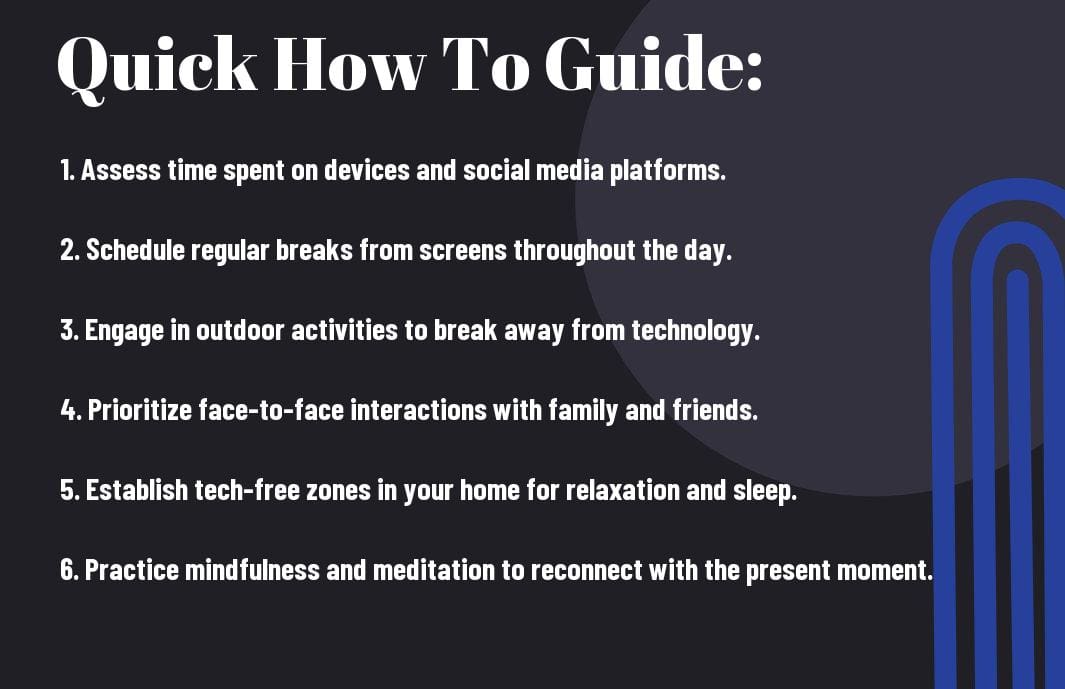Just as our digital devices have become an integral part of our daily lives, so too has the need to disconnect from them to reconnect with ourselves and those around us. In a world where constant connectivity can lead to increased stress, anxiety, and decreased productivity, finding balance is crucial for our well-being. This guide will provide you with practical tips and strategies to help you establish boundaries with technology, prioritize self-care, and nurture meaningful relationships in the digital age. By taking intentional steps to disconnect, you can reconnect with yourself and the world around you, leading to a more balanced and fulfilling life.
Key Takeaways:
- Prioritize self-care: Make time for activities that promote relaxation and self-care, such as meditation, exercise, or spending time in nature.
- Set boundaries: Establish boundaries around your technology usage to prevent digital burnout. Designate tech-free zones or times during the day where you disconnect from devices.
- Cultivate real connections: Focus on building and nurturing real-life connections with friends and family. Engage in meaningful conversations and activities that strengthen your relationships.

Assessing Your Digital Habits
Identifying Overuse and Dependency
One of the first steps to finding balance in a digital world is identifying if you have developed an overreliance on technology. Signs of overuse and dependency include constantly checking your phone, feeling anxious when separated from your devices, or neglecting real-world responsibilities in favor of screen time. It’s important to recognize these behaviors to begin the journey towards a healthier relationship with technology.
Tracking and Analyzing Your Digital Consumption
One effective way to assess your digital habits is by tracking and analyzing your digital consumption. Take note of the amount of time you spend on different devices and applications each day. This information can help you understand where your time is predominantly spent and identify areas where you may be overindulging. By tracking your usage, you can make more informed decisions about how to limit screen time and prioritize meaningful offline activities.
Strategies for Digital Detox
Setting Realistic Goals and Boundaries
To successfully disconnect and reconnect, it is crucial to set realistic goals and boundaries for your digital detox. Clearly define your goals for reducing screen time, whether it’s limiting social media usage, setting designated tech-free times, or establishing no-phone zones in your home. Be specific about the boundaries you want to set to create a healthier relationship with technology.
Mindfulness and Being Present
Some of the key strategies for a digital detox involve mindfulness and being present. By practicing mindfulness, you can bring your focus back to the present moment and reduce the distractions of technology. Mindfulness techniques such as meditation, deep breathing, or simply observing your surroundings without judgment can help you reconnect with yourself and those around you.
Goals should focus on increasing awareness of digital habits, learning to reconnect with the offline world, and finding a balance between the benefits of technology and the need for real-world interaction. By incorporating mindfulness into your daily routine, you can cultivate a greater appreciation for the present moment and improve your overall well-being.
Tips for Maintaining Digital-Real Life Balance
All too often, we find ourselves engrossed in a digital world, leaving little time for the real-life experiences that truly matter. To strike a balance between the two realms, here are some imperative tips to help you disconnect to reconnect:
- Set Boundaries: Establish specific times during the day for digital use and stick to them.
- Practice Mindfulness: Be present in the moment and limit distractions from technology.
- Engage in Offline Activities: Discover hobbies and interests that don’t involve screens.
- Nurture Real Connections: Prioritize face-to-face interactions over virtual ones.
Perceiving the value of time spent in the physical world will lead to a more balanced and fulfilling life.
Cultivating Offline Hobbies and Interests
Even in a hyper-connected world, it’s crucial to cultivate offline hobbies and interests to maintain a healthy balance. Engaging in activities like painting, hiking, cooking, or gardening can provide a much-needed break from screens and foster creativity and relaxation.
Fostering Personal Relationships Outside Social Media
Social media has revolutionized the way we connect, but it’s imperative to foster personal relationships outside of these platforms. While social media can help us stay in touch, nothing beats the richness of face-to-face interactions. This direct contact allows for deeper connections, greater empathy, and more meaningful conversations that can strengthen bonds in ways a digital exchange cannot match.
Embracing the Benefits of Disconnection
Improved Mental and Physical Well-being
Now is the time to prioritize your mental and physical well-being by disconnecting from the digital world. Constant exposure to screens and notifications can lead to increased stress, anxiety, and even physical health issues. By taking regular breaks from technology, you can improve your focus, sleep quality, and overall health.
Enhancing Real World Connections and Productivity
World
Now is the time to focus on enhancing your real-world connections and productivity by disconnecting from digital distractions. By stepping away from your devices, you can fully engage with the people around you, deepen your relationships, and boost your productivity at work. Make a conscious effort to set boundaries with technology to make meaningful connections and achieve your goals.
Understanding the detrimental effects of constant digital connection is crucial in realizing the importance of disconnecting. Research has shown that excessive screen time can lead to social isolation, decreased productivity, and even depression. By disconnecting, you can break free from these negative impacts and embrace a more balanced and fulfilling life.

Conclusion
From above, it is evident that finding balance in a digital world is crucial for our overall well-being. By disconnecting from screens and technology, we can reconnect with ourselves, others, and the world around us. Setting boundaries, practicing mindfulness, and engaging in offline activities are key strategies to achieve this balance. Bear in mind, it’s okay to unplug and take a break from the digital noise to prioritize self-care and real-life connections. Embrace the power of disconnecting to truly reconnect with what matters most in life.
FAQ
Q: Why is it important to disconnect to reconnect?
A: Disconnecting from the digital world is crucial for finding balance and maintaining overall well-being. Constant exposure to screens and technology can lead to increased stress, anxiety, and decreased productivity. Disconnecting allows for time to rest, recharge, and focus on meaningful real-life interactions.
Q: How can I incorporate disconnecting into my daily routine?
A: To disconnect effectively, start by setting boundaries around screen time. Designate specific times of the day to be technology-free, such as during meals or before bedtime. Engage in activities that do not involve screens, such as reading a book, going for a walk, or spending time with loved ones. Prioritize self-care and mindfulness to create a healthy balance between digital and real-world experiences.
Q: What are the benefits of disconnecting to reconnect?
A: Disconnecting to reconnect offers numerous benefits, including improved mental health, better focus and productivity, enhanced relationships, and increased creativity. By taking breaks from the digital world, you can reduce feelings of overwhelm and create space for personal reflection and growth. Finding balance in a digital world allows for a more fulfilling and enriched life.




